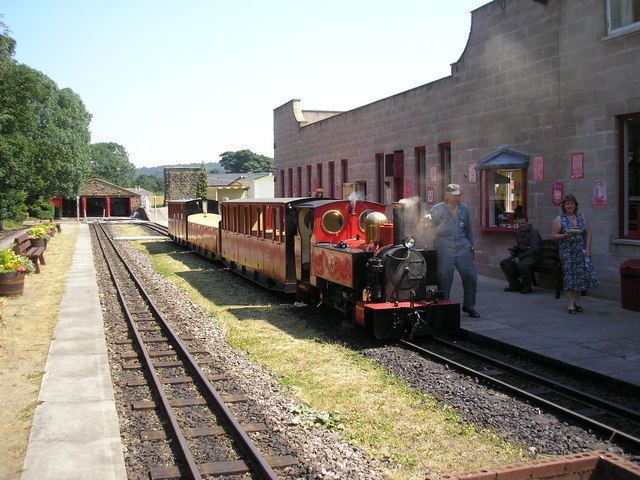Terminus Clayton West Length 3 ⁄2 miles (5.6 km) 1 September 1879 opened Locale West Yorkshire | Name Clayton West branch Preserved gauge 15 in (381 mm) Phone +44 1484 865727 Termini Clayton West | |
 | ||
Original gauge 4 ft 8 ⁄2 in (1,435 mm) standard gauge Address Park Mill Way, Clayton West, Huddersfield HD8 9XJ, UK Built by Lancashire and Yorkshire Railway Similar Cleethorpes Coast Light Railway, Standedge Tunnel and Visitor Ce, Elsecar Heritage Railway, Shelley railway station, Amerton Railway Profiles | ||
Kirklees light railway gala fairbourne in the hills 11th september 2016
The Kirklees Light Railway is a 3 1⁄2-mile (5.6 km) long 15 in (381 mm) gauge minimum gauge railway in Kirklees metropolitan borough, West Yorkshire, Northern England.
Contents
- Kirklees light railway gala fairbourne in the hills 11th september 2016
- Kirklees light railway steam gala 13th september 2015
- History
- Stations of the KLR
- Locomotives
- Steam locomotives
- Diesel locomotive
- Petrol locomotives
- References
First opened on 19 October 1991, the KLR runs along the trackbed of the Lancashire & Yorkshire Railway's now long closed/former branch line, from the village of Clayton West via Skelmanthorpe to the village Shelley Woodhouse (a few yards close to the former Clayton West Junction 1⁄2 mile (0.80 km), near Shepley) on the Penistone Line from Huddersfield to Sheffield, (via Penistone and Barnsley).
Kirklees light railway steam gala 13th september 2015
History
The Lancashire and Yorkshire Railway opened their branch line from Clayton West Junction to Clayton West on 1 September 1879. The branch line was built with bridges, tunnels and earthworks suitable for a double line in case of a proposed extension to reach Darton on the Dewsbury to Barnsley Line, but only one line was ever laid and despite attempts to extend the railway, Clayton West was to remain as a terminus.
The line survived the Beeching cuts in large part thanks to the mineral traffic generated by the collieries at the terminus (Park Mill) and at Skelmanthorpe (Emley Moor), but was sadly not adopted by the West Yorkshire Passenger Transport Executive unlike nearly all other passenger lines in West Yorkshire and was closed to passengers on 24 January 1983. Coal was still transhipped from Emley Moor Colliery to Elland power station until 1984 and tracklifting of the branch was completed in 1986.
Construction of the minimum gauge railway started in mid-summer 1990, following a joint application for a Light Railway Order between Kirklees Council and the Kirklees Light Railway Company on 22 February 1989. Construction was aided significantly by the amount of redundant materials available from a number of collieries in the area which were slowly beginning to end their mining operations. The Light Railway Order was finally granted on 27 September 1991.
The line was originally 1 mile (1.6 km) in length running from Clayton West station to a specially constructed halt called Cuckoos Nest. This name is historic to 15 inch gauge railways as a station on the Eaton Hall Railway, near Chester, built by Sir Arthur Heywood bore the name. Trains to Cuckoo's Nest commenced running on Saturday 19 October 1991. The KLR was later extended to Skelmanthorpe in 1992 and again to a station at Shelley in 1996/7 with a grant from ERDF for the regeneration of coal mining areas.
The journey gives fine views of the Grade II listed Emley Moor transmitting station, passes through the ancient woodland of Blacker Wood which is mentioned in the Domesday Book and includes a trip through the 511 yards (467 m) long Shelley Woodhouse Tunnel, the longest tunnel on any 15 in (381 mm) gauge line in Britain.
The original line as built was 3 1⁄2 miles (5.6 km), but upon reopening as the Kirklees light railway, the line is short of the former Clayton West Junction on the Penistone Line and the length of the light railway is 3.04 miles (4.89 km).
Stations of the KLR
Locomotives
All the locomotives used on the railway were built by the railways founder Brian Taylor. They have all benefited from the application of modern steam principles advocated by Livio Dante Porta. These modifications have improved the locomotives performance, reliability and efficiency.
Steam locomotives
The following are approximately half size narrow gauge locomotives:
